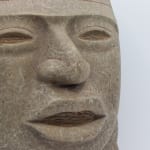Teotihuacan Standing Figure, 200 to 600 CE
height 29 cm
height 11 3/8 in
height 11 3/8 in
LI.3421
Further images
-
(View a larger image of thumbnail 1
)

-
(View a larger image of thumbnail 2
)

-
(View a larger image of thumbnail 3
)

-
(View a larger image of thumbnail 4
)

-
(View a larger image of thumbnail 5
)

-
(View a larger image of thumbnail 6
)

-
(View a larger image of thumbnail 7
)

-
(View a larger image of thumbnail 8
)

-
(View a larger image of thumbnail 9
)

-
(View a larger image of thumbnail 10
)

-
(View a larger image of thumbnail 11
)

An exceptional example of Teotihuacan Stone Idol finely carved in Greenstone. This artefact represents fully the basic canons of Teotihuacan iconography, with a schematic representation of the human body topped...
An exceptional example of Teotihuacan Stone Idol finely carved in Greenstone. This artefact represents fully the basic canons of Teotihuacan iconography, with a schematic representation of the human body topped by an oversized head. This disproportionately large head displays conventionalised features of Teotihuacan art: a squared off head and ears, linear brow merged in the forehead, and a protruding and open mouth. The ear holes, eyes, and mouth likely once held ornaments or inlays of shell, pyrite, or another precious material, this is further indicated by the rough surface of those areas contrasting the polish rendering of the surface of the sculpture, pointing out that most probably those points would have not been visible. Subtle, fluid incisions and raised areas indicate garments, the bend of the arms, wrist bones, and fingers.
Standing figures of this scale and of three-dimensional form are extraordinarily rare in the corpus of Teotihuacan sculpture, with the Metropolitan Museum of New York reporting of the existence of only about a dozen known examples. Similar sculptures excavated at the city center indicate that these types of works were used in private rituals in interior shrines, or in the monumental temples of Teotihuacan.
Teotihuacan is referred to as the city of the gods. By 600 A.D. it was the sixth largest city in the world. Situated in a temperate, fertile basin its fame spread as quickly as its prosperity, with well-established trade routes and a culture that is still impressive today. A booming economy gave rise to an urban elite that in turn fostered intellectual activity, monumental building and the belief Teotihuacan was where the cosmos and the present cycle of life began. The concept of monumentality can apply not only to great architectural structures such as the Pyramid of the Sun, but also to much smaller objects which have an intensity that makes them larger than life. Although the great civilization of Teotihuacan met its untimely end around 700 A.D., by the hand of invaders, the creative spirit of the people lives on in their enduring artist creations and spectacular ruins.
Standing figures of this scale and of three-dimensional form are extraordinarily rare in the corpus of Teotihuacan sculpture, with the Metropolitan Museum of New York reporting of the existence of only about a dozen known examples. Similar sculptures excavated at the city center indicate that these types of works were used in private rituals in interior shrines, or in the monumental temples of Teotihuacan.
Teotihuacan is referred to as the city of the gods. By 600 A.D. it was the sixth largest city in the world. Situated in a temperate, fertile basin its fame spread as quickly as its prosperity, with well-established trade routes and a culture that is still impressive today. A booming economy gave rise to an urban elite that in turn fostered intellectual activity, monumental building and the belief Teotihuacan was where the cosmos and the present cycle of life began. The concept of monumentality can apply not only to great architectural structures such as the Pyramid of the Sun, but also to much smaller objects which have an intensity that makes them larger than life. Although the great civilization of Teotihuacan met its untimely end around 700 A.D., by the hand of invaders, the creative spirit of the people lives on in their enduring artist creations and spectacular ruins.










